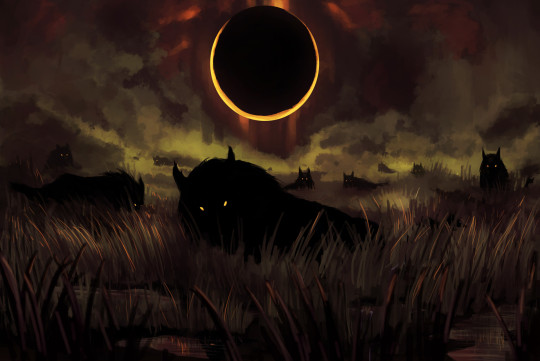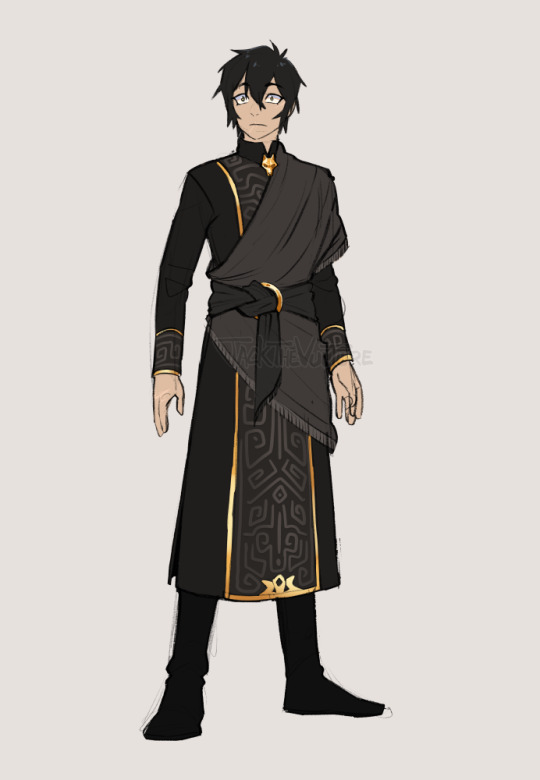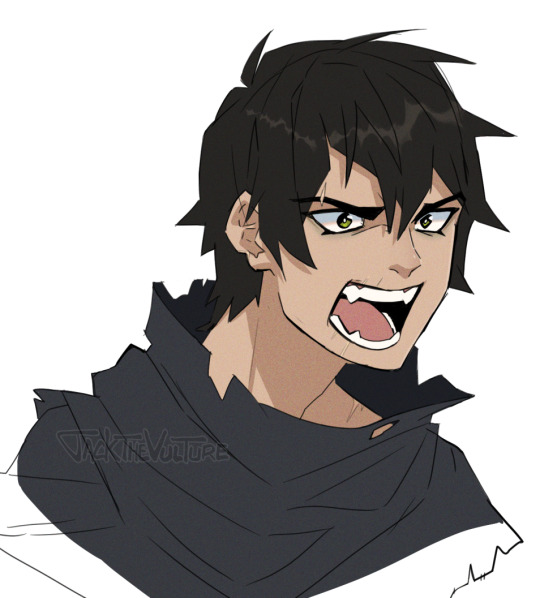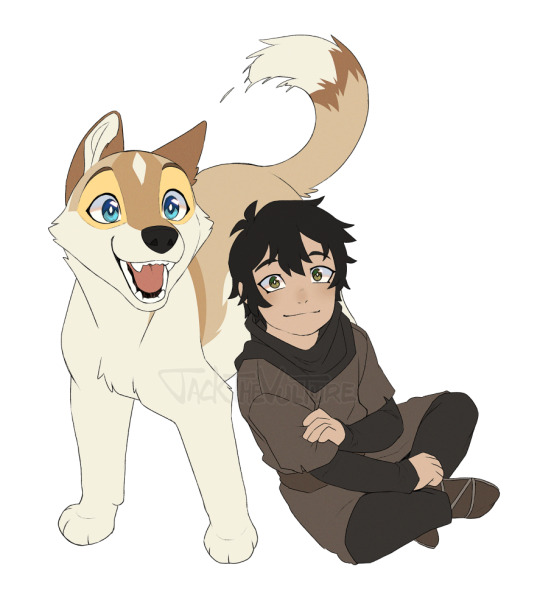#worgs
Explore tagged Tumblr posts
Note
Hello Dapper. I don’t really expect too much about this, but do you have any ideas for Wargs? They have an interesting relationship with goblins and are weird in that they’re essentially sapient wolf monsters, but I don’t think they’re ever really used that creatively.

Monsters Reimagined: Wargs, wolf panics, and the Economics of Lupophobia
While the surface level answer is pretty simple (warg is a conversion of varger, an old Norse way to refer to mythological wolves like Fenrir) there's actually a surprising amount of material to drill into here on the topic of sapient wolf monsters, especially for someone like me who has a interest in moral panics and mass hysteria events. Wolves were effectively a boogyman for pre-industrial societies, a deep seated generational fear that we only recognize today through cultural relics like the big bad wolf or boy who cried wolf.
TLDR: If you want to do something interesting with wargs beyond just "wolves that talk" I'd advise playing to their folk / fairytale roots. They're creatures of embodied dread, drawn from the stuff of the feywild to sow fear among those who would travel off the path or too close to the wilderness. This lets you tell interesting stories about how the party/major characters respond to fear: Does fear of being attacked in the dark drive the party to make risky decisions that might endanger their quest? How do the villagers react when the wolves are very literally at the door, demanding just one of their neighbours as a meal in exchange for safety?
I'd also advise getting weirder with a warg's powers, playing into that fear of the unknown by doing unexpected things. The party can fight off a pack of wolves, sure, but what does it mean when the lead wolf rips off the bard's shadow and takes off into the night?
Background: If you want a window into the headspace of wolf-panic, think about the neigh omnipresent fear of sharks created by the Jaws franchise. Children who have never seen the movie, let alone seen a shark in person can become irrationally afraid of getting into deep water because they've absorbed the pervasive cultural phobia, which goes onto shape environmental policy as sharks are overhunted or killed out of spite for their perceived threat.
So it was for wolves, even after they were largely hunted to near extinction by medieval and postmedieval societies, the fear of them was so ingrained into cultural traditions that wolf and werewolf panics were a thing that went hand in hand with witchtrails. France had a country wide one as late as the 1760s and the movie based on it ended up inspiring Bloodborne. Alternatively look at the anti-wolf efforts during the colonization of the Americas, right up to the opposition to reintroducing wolves back to Yellowstone park.
On that note (and because we can't have a Monsters Reimagined without some kind of class analysis), lets talk about how these fears are propagated: On many levels it makes sense for everyday people to be afraid of wolves, they're a hunting species that can absolutely pose a danger to us, and when you're living or travelling outside the protection of a settlement you really are vulnerable to a coordinated pack of carnivores running you down.
However, the primary threat that wolves pose to humans isn't predation, it's property damage, specifically in how they kill livestock. While we can talk about individual farmsteads beset by beasts, in reality the herds that wolves were most likely to prey upon belonged to the landowning classes, powerful people who had a profit incentive in seeing wolves driven off or exterminated. This is where you get bounties on dead wolves, not just paying for the value of the hide but actively rewarding people for going out and killing as many wolves as possible to the point of it becoming a profession. This practice has existed for MILLENIA and is still active today, primarily in places where big agriculture influences governments.
It seems incidental at first but then you realize that it fits the model of just about every other kind of cultural panic: widespread ignorance and fear that just so happens to mobilize the populace in a way that financially benefits a select few. You can see the same thing happening today in england with badgers of all things, which have been identified with the local dairy industry as a threat to their herds. This is not only led them to petition the government to cull the badger population, but to put out anti-badger propaganda, eventually turning it into a culture war issure to the point where conservative mouthpieces like Jeremy Clarkson openly encourages killing and gassing badgers on sight.
Returning to the land of fantasy for now: I think it's worth taking the idea of the warg and mixing it with a few other "black dog" cultural archetypes, which can also include the creatures like the shuck or church grimm. In this instance the warg is a sort of curse made manifest, the fear of a haunted place given literal teeth. People who transgress into these forbidden spaces find themselves pursued by a manifestation that dogs them till they're exhausted and vulnerable, much like a wolf harrying its prey.
The bhargest is also of special interest here, considering how I like to relate goblins back to the feywild. You could easily see bhargests as agents of fey that feed on human fear, leading a pack of goblins or hobs that occupy the desolate lands they've called to haunt. My version of Maglubiyet would also delight in employing such creatures as his emissaries.
Going back to the vargr/ Norse mythology angle, it's interesting that most of the wolves that show up are destined to devour something, whether it be a god or celestial certanty like the moon and sun. It's like the concept of an inevitable chase is so fundimental to what a wolf IS that it became a theme of ragnarok's inevitable certantly. Consider having certan packs of wargs be offspring of some fenrir style god eater, beasts of forboding doom who's mere presence is an omen of ill times.
Alternatively, if you wanted to play on the big bad wolf angle, give wargs the ability to take on flimsy human disguises, all the better to get close to their pray and sow fear among the townsfolk. Historical wolf panics after all are not all that different than serial killer panics, and it'd be a fun twist on a traditional werewolf adventure to have the party on a creature that didn't play by the usual lycanthropic rules.
Artsource
214 notes
·
View notes
Text


worgtaurs (?) or something like that
#inspired by bg3 worgs depiction :)#digital art#art#character design#illustration#dnd#dungeons and dragons#artwork#worg#worgs#worgtaur#fantasy character#fantasy#anthro#dnd art#q
56 notes
·
View notes
Text
Folklore Fact - Wargs (or vargs or worgs)
Wargs (aka worgs, if you play D&D) handily won the poll for August's folklore fact. What are these giant wolves like, anyway, and are they really all evil in legend?

The jötunn Hyrrokin riding a wolf, on an image stone from the Hunnestad Monument, constructed in 985–1035 AD
As usual, let's start with etymology. The word “warg” comes from Old Norse “vargr” (plural “vargar”), meaning - essentially - "destroyer." Originally, the term is thought to have meant "wolf," but over time, it shifted to refer to criminals (with an inherent negative meaning) instead. Thanks particularly to Tolkien, it is now widely used in scholarship to refer to the various giant wolves of Norse mythology, such as perhaps the mightiest and most terrifying monster in Norse myth, Fenrir (destined to swallow Odin during Ragnarok), along with Skoll (destined to swallow the sun) and Hati (destined to swallow the moon).
Note that this was not the common Old Norse word for wolf. "Varg" came to have a specifically negative connotation, whereas "ulf" (meaning simply "wolf") did not.
There were also plenty of other wargs/giant wolves in Norse myth, often being used as mounts to various gods and giants and other extremely powerful individuals; they were particularly favored of the jötnar, who, despite the simplification in a lot of modern media, were not always universally malevolent and hostile toward the gods. The runestone seen above depicts the giantess Hyrrokin who arrived to assist the gods with shoving off Baldr's funerary ship during Baldr's funeral, as no one else could move the vessel. She arrived riding on the back of a huge wolf so mighty that, after the giantess dismounted, even Odin's berserkers could not restrain it until it was knocked unconscious.
Does this also make Odin’s wolves, Geri and Freki, "wargs" in the modern scholarly concept? That was never really specified. But they are giant, godly wolves, perhaps meant to be the fathers of all wolves everywhere, so… Maybe? In some tales, during Odin's wanderings, Geri and Freki spread their wolf offspring across the world. Thus, it is possible they are simply giant godly wolves rather than specifically "wargs," but it's also possible that mythology wasn't ever planning to be that nitpicky and specific. Odin was, of course, also the creator of the berserkers, which gives him yet another wolf connection.
Going back to etymology for a moment, "ulf" was frequently incorporated into personal names. Wolves were not seen as wholly undesirable in Norse culture; to claim wolves were always seen as "evil" or somehow "negative" is to simplify the concept beyond belief. Wolves were admired for their fabled ferocity, endurance, will to live, voracity, and prowess in battle. Thus, wolves became a symbol of strength and a desirable image for great warriors. Though often feared, this fear is precisely what led many warriors to desire to be like a wolf, for they too desired ferocity feared by those around them. Wolves were a force of nature, an uncontrollable power to be respected (such as the power of the berserkers, again, who themselves were associated with wolves and, despite their connections with the god Odin, were also at once frequently seen as undesirable but worthy of respect), not simply a force of black and white "pure evil." How terrifying they were led to wolves becoming arguably the most powerful and feared monsters in Norse myth, but likewise, it was an image their warriors often wanted to take up and present.
While the majority of named giant wolves from Norse myth are certainly evil, such as Fenrir, what truly popularized the modern concept of the evil wargs in popular culture was - of course - the father of all fantasy and unmatched scholar JRR Tolkien. Likewise, Tolkien popularized the idea of goblins and/or orcs riding giant wolves into battle, no doubt inspired by the jötnar of Norse myth. Obviously, Norse and other myths greatly inspired many elements of The Lord of the Rings. Wargs are no different, but he did of course put his own interpretation upon them - an interpretation that has, like so many of his creations, become staples of many fantasy settings and even the popular mindset.
Whereas wargs in myth are at least semi-divine mounts of gods and giants, the wargs by the Third Age of The Lord of the Rings are mounts for goblins and their ilk. However, the wargs are intelligent and even have a sort of language, one some beings (such as Gandalf, notably inspired to no small degree by elements of Odin, himself) can understand, even if it is an evil tongue and they use it to speak only of evil things, as seen in The Hobbit. In the books, the wargs are often associated with Tolkien's very unfortunate portrayal of werewolves. I won't get into all the details of that. I adore Tolkien and all his works beyond my love for virtually anything else, but I cannot say I love his portrayal of "werewolves," though I do understand them.
So where then do we get this spelling of "worg?" That's entirely Dungeons and Dragons. Oldschool D&D wholesale ripped off Tolkien - which is one reason why oldschool D&D is so great - and had to change some of the terms they used. Balrog became balor, hobbit became halfling, mithril became mithral, etc. The same applies to "warg," Tolkien's term, which became "worg" in Dungeons & Dragons.
So where does this leave A Song of Ice and Fire aka Game of Thrones, with the "wargs" that are "skinwalkers" who can "warg" (verb) into animals, etc, and see through their eyes? There were plenty of legends out there - from Norse myth and otherwise - wherein people could project their consciousness into the bodies of animals when they slept or otherwise entered a kind of trance (some legends that could be considered werewolves also worked this way), but the term "warg" was never used to refer to such acts.
Ultimately, the modern concept of wargs is yet another major fantasy element that Tolkien alone conceptualized into what it is now in broader popular culture. Yes, it is certainly based on Norse myth, but Tolkien is the one who gave us our popular concepts of them today.
That's it for a general overview! This is a vast topic into which I could delve far deeper, but now you should have some general idea.
If you like my blog, be sure to follow me here and elsewhere for much more folklore and fiction, including books, especially on werewolves! You can also sign up for my free newsletter for monthly werewolf/vampire/folklore facts, a free story, book previews, and my other sundry upcoming projects and works, such as plushes (including all your werewolf and wolf and mythology plush desires). Please also consider supporting me over on Patreon (link at bottom of post); I promise you'll get awesome rewards in return, and every little bit really does help me continue my work.
And stay tuned for news and updates on a major [character-driven werewolf/fantasy/adventure/horror/semi-epic] book release coming THIS NOVEMBER!
Free Newsletter - maverickwerewolf.com (personal site + shop + free fiction) — Patreon — Wulfgard — Werewolf Fact Masterlist — X — Vampire Fact Masterlist — Amazon Author page
#warg#wargs#varg#vargs#worg#worgs#folklore#folklore fact#mythology#norse mythology#norse myth#history#wolf#wolves#resources#research#monsters#creatures#myth#dungeons and dragons#game of thrones#tolkien#lord of the rings#the hobbit#ragnarok#fenrir#fenris#werewolf wednesday#werewolfwednesday#folklore thursday
53 notes
·
View notes
Text


Li'l commissions for a friend of two NPCs from her Phandelver campaign I'm in: King Grol, bugbear warlord, and his...close relative, Snarl the worg.
Look. Don't ask questions you don't want the answers to.
#worgs pass the harkness test#i did not ask for details but i respect it#bugbears#dnd#d&d#dungeons and dragons#worgs#wolves#fantasy#my art#sketches#monsters#image description in alt
12 notes
·
View notes
Text

Comm for @deathbypixelz
#world of warcraft#night elf#kaldorei#wolf#worg#goldrinn#commission#kottart#this one good practice for drawing wolves (with tusks)
238 notes
·
View notes
Note
Weird but genuine question… how do you deal with the fandom’s misogyny and/or racism? I have been in many fandom and asoiaf is not the worst I have been in but I am still relatively shocked whenever I see a very… particular opinion. And since I saw you were in the fandom for a long time I thought to ask you, if you are alright with answering that.
How do I deal with it? I block a lot of people. Tumblr not so much (its issues are not usually those topics at least), but twitter, ugh god. And I avoid reddit and westeros.org forums like the plague. (I pay attention to exactly one thread on worg, and that is the one where wiki editors debate what to do with the wiki.) Actually, it was exposure to worg's misogyny that kept me from getting into the fandom after I first read the books back in 2005, and it wasn't until I found tumblr shortly before the release of ADWD in 2011 that I actually began to pay attention and contribute to the fandom. (As I've said before, somehow during 2005-2011 I totally missed there was an active ASOIAF fandom on LiveJournal, which is a pity because it was exactly what I was looking for but did not find on worg.)
And I also do my best to counter such bullshit when I see it. Not always mind you -- again, blocking is a girl's best friend, and I'm not seeing such things on the websites I refuse to go to -- but if I get certain types of asks, I answer accordingly. And if I see certain things in posts in the tags here on tumblr, I'll answer there as well. (Not usually with a public reblog-and-shame due to the number of followers I have likely causing dogpiles, but I will comment.) Twitter however is a lost cause, though, if you're there please just slam that block button over and over again. Or again, don't go there. Honestly ASOIAF fandom should've left ElonXnazitown years ago, sigh...
Anyway, best of luck in this fandom, and please take care of yourself!
#asoiaf#anonymous asks#asoiaf fandom#oh fandom#block 'em all and let god sort them out#the other day someone on worg messaged me to ask how i had a 13-year-old account with under 50 posts. man i'm just there for the wiki lol
22 notes
·
View notes
Text

On the left, the Umber Hulk, 8 ft (2.4 m), about as smart as your average person, and can confuse and disorient people with thier gaze! Beneath a hide covered in chitinous plates is a very muscular body. One strong enough to tear through 10 ft (3 m) of solid rock in 6 seconds. Apparently the eldest of them can grow to 16 ft (4.9 m) and become very good at reading people.
The Worg (right) is a wolf-like creature, knows 2 or 3 languages, and are known for turning on thier riders if mistreated! Last they bothered listing the size they were 3 ft (91 cm) at the shoulder, 5 ft (1.5 m) long. But the picture shows it at nearly twice that, around 5 ft (1.5m) tall and 8 ft (2.4 m) long. Whichever works for you I suppose, maybe it's regional.
191 notes
·
View notes
Text






Sigh...so Arban here was my first actual DnD character that I got to play. Basically the exact character I'd been dreaming of playing since I discovered the concept of DnD: a lawful evil Oath of Conquest paladin. The campaign started back in I think 2020 as a solo campaign, with the DM and me making up Arban's (back)story to fit the world. All the characters in his story were the DM's NPCs, Arban's history and motivations were tied to the plot, later two other people joined the campaign and I had an absolute blast...
Then about ten sessions in the DM got too busy and had to end the campaign. Completely understandable and no hard feelings toward the DM, but it was still a huge disappointment. So yeah, RIP Arban, I don't really know what to do with you anymore. But I enjoyed the time I got to awkwardly roleplay you.
30 notes
·
View notes
Text

It's been a long time since I posted but I was sketching and end up in "jack", I can't believe this piece of sunshine is evil
#kagarumo genmaru#kagarumo art#artist#fypage#artists on tumblr#draw#fan art#somethins is worg with sunny day jack#sunny day jack#swwsdj
147 notes
·
View notes
Text



I really love how they turned out, imma share this so y'all can take a closer look :>
29 notes
·
View notes
Text

Monster Tidbits - Worg
112 notes
·
View notes
Text





I realize ive NEVER POSTED ERU HERE so here is my current ttrpg character, Eru. Hes a Druid, was raised by Worg which in this universe are basically just giant, long lived wolves with human level intelligence and speech. He sees himself as a Worg, and was thriving with his family before his parents were killed and his sister taken captive. After a period of darkness and depression the god of the forest reached out to him and he began his life as a druid, and set out on a mission to save his sister and return to protect his forest.
Hes a good boy whos goin through it. He was a pretty well adjusted if a little insecure before his parents deaths, but the trauma of losing them to hunters changed a lot about him. At his core, he is still kind, a bit awkward, and thoughtful. He is skeptical of humanoids, but loyal to those who aid him.
Eru's Toyhouse.
173 notes
·
View notes
Text

More fae Vat’il scribbles. The gnolls are worgs because I said so
62 notes
·
View notes
Text

Shoulda been born a Frostwolf Orc so I could have horse sized puppy
17 notes
·
View notes
Text
There are a number of really interesting creature types from monstrosities to dragons to aberrations. While I find these creature types fascinating I do often find myself in a hard position, most creatures cannot be multiple creature types at the same time. The only exception I've really seen of this is Humanoid (Goblinoid) but that's a type of Humanoid (technically). I want beast goblinoids, fey goblinoids, and even celestial goblinoids.
So I propose we start using more than one creature type for creatures we place the primary creature type first and then hyphenate and add another creature type. For example, let's say we want a fey goblinoid who's still a humanoid I propose we do it like this Fey-Humanoid (Goblinoid) where Fey is the primary and Humanoid is second, if any effects struggle due to a limited distinction we just go on their order, so if it targets humanoids and specifies it cannot affect Fey then we look at the order, Fey is first so it is immune.
Have I lost my mind or does this kinda make sense? There should also be more of the 'oids' I've seen some people say Dragonoid which I really like (not gonna lie I feel like Dragon shouldn't be a creature type and it should just be listed under Beast but this is not the time for that rant.)
#dnd#d&d#goblin#creature type#goblinoid#worg#bugbear#torbek#seriously though why are dragons a creature type they're big scale puppies#they might even be considered a danger scale kitty
6 notes
·
View notes






